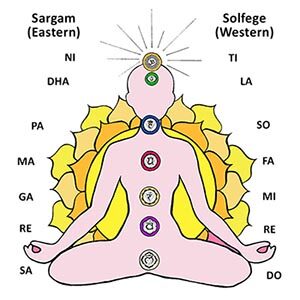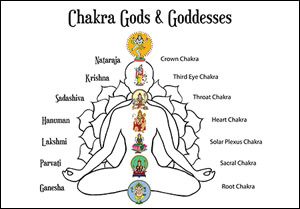
Chakras and Musical Notes
Chakras and musical notes have been paired in a number of ways. A simple system is to assign sequential notes from the C Major scale to each of the chakras from the root to the crown: C (root), D (sacral), E (solar plexus), F (heart), G (throat chakra), A (third eye) and B (crown chakra).
Musical Systems of East and West
The science of sound goes even deeper than this basic parallel construction of notes of the scale and chakras. Some researchers say that the ratio of frequencies is more important than an exact pairing of chakras and musical notes. For example, the exact frequencies may be affected by the size of the individual, though the proportions or ratios from chakra to chakra may remain the same.
Using Sound to Clear the Chakras
Other systems assign specific syllables to the chakras and musical notes, asserting that singing these sounds is the best way to clear and stimulate the chakras. The musical notes covered in this article include the Eastern sargam system, the Western solfege system, and metaphysical aspects of the notes associated with the chakras.
Share this page with a friend!
Table of Contents
Chakra Musical Notes in the East
Solemnization is the practice of using syllables to teach pitch and sight reading. This practice aids in the recognition of the different steps of the scale. This approach originated in ancient India with a system known as sargam. Sargam is composed of seven tones called svaras or swaras.
The word “svara” actually encompasses more than a tone. Its meaning also includes the breath, musical note, a specific color, and a vowel. In addition, there is an indication of the location of articulation for producing the sound. Even more importantly, the word Isvara is a name for the absolute God.
The Indian musical octave is said to be derived from the Samveda, an ancient text likely written down somewhere between 1200 and 1000 BCE. This book is dedicated to music and chanting. The name Samveda generally means “the knowledge or storehouse of melodies.”

Sargam Musical System
In the Indian system, the notes of the scale are paired with the following syllables: SA, RE, GA, MA, PA, DHA, NI, SA. Thus, the chakras and musical notes in this system would be: SA (root), RE (sacral), GA (solar plexus), MA (heart), PA (throat chakra), DHA (third eye chakra) and NI (crown chakra).
The note names are an abbreviation of the full note names: SA for shadja, RE for rishaba, GA for gandhara, MA for madhyama, PA for panchama, DHA for dhaivata and NI for nishada. There are fascinating associations between the notes, the sounds of animals, astrology, and colors.
- SA from the cry of a peacock; associated with the planet Mercury; green in color
- RE from the lowing of a bull; associated with Mars; red in color
- GA from the bleating of a goat; connected to the sun; golden color
- MA from the call of a heron; associated with the moon; white in color
- PA from the call of a cuckoo; aligns with the planet Saturn; color is blue or black
- DHA from the neighing of a horses; associated with Jupiter; yellow color
- NI from the trumpet of an elephant; connected to the planet Venus; multi-colored
Chakras Musical Notes in the West
A Benedictine monk named Guido d’Arezzo was familiar with the Indian sargam. He invented a similar system to use with Western music. Guido felt that most of the Gregorian chants popular at that time could easily be learned by singers if they could associate visual symbols with particular syllables and sounds. In this way, they could see the tonal progression up and down the scale.
Watch nearly 400 videos on the Vocal Medicine Channel!
The Birth of DO-RE-MI
Guido assigned a specific syllable to each of the note of the musical scale: Do, Re, Mi, Fa, Sol, La, Ti, Do. These syllables came from Ut Quent Laxis, a well-known hymn of the Middle Ages that was chanted for vespers or evening service.
Western Solfege System
Each succeeding line of the song started one note higher that the previous one. Guido used the first two letters of the opening words from each line to create a western form of solfege.
Latin Origin of Do RE MI
- DO or UT-quent laxis
- RE-sonare fibris
- MI-ra gestorum
- FA-muli tuorum
- SO-lve polluti
- LA-bii reatum
- TI or SI-Sancti Iohannes
Translation of Hymn
- DO let our voices
- RE-sonate most purely
- MI-racles telling
- FAr greater than many
- SO let our tongues be
- LA-vish in Your praises
- (SI or TI) Saint John the Baptist
Metaphysics of Chakras and Musical Notes
Vocal teachers have understood and taught this tonal progression in a variety of ways. A number of them have recognized that there is also an energy shift on a metaphysical level as you move through the notes of the scale. Each note can be viewed as a shift in energy from unmanifest potential to unification.
Energy Shifts and Musical Notes
In other words, the sound and energy are more diffuse and grounded at the lower tones and concentrated like a laser beam as you move up. For example, the tones that are produced higher in the body are often referred to as head tones. These tones affect the brain and glands within the brain. From this standpoint, the scale can be viewed as a general progression and shift of energy.
DO: Unmanifest Potential
RE: Felt Potential
MI: Gathering Energy
FA: Devotional Energy
SOL: Fearlessness
LA: Intuition
TI: Merging
DO (next octave): Unification
Other Aspects of Chakra Sounds
In addition to chakras and musical notes, chakras are also affected by vocal toning, musical instruments, vowel sounds, bija syllables and more. Explore each of these areas in the following articles: Chakra Sounds and Chakras and Vowel Sounds.
More Chakra Resources
Chakras and Musical Notes: Chakras and musical notes have been paired in a number of ways. Learn about both Western and Eastern systems.
Chakra Names: Chakra names reveal the roles of the chakras in the body on psychological, spiritual and emotional levels. Includes explanations of English and Sanskrit chakra names.
Chakra Flowers: Chakra flowers offer unique symbolic meaning for each of the seven major chakras. Flowers are among the oldest spiritual symbols, revealing the meaning of each chakra.
Author Kathleen Karlsen
Kathleen Karlsen is a musician, artist, writer and speaker. She is the author of two books (Flower Symbols and Vocal Medicine) and over 200 articles. Kathleen, her husband Andrew, and their five children live in Bozeman, Montana. More about Kathleen Karlsen.
CHAKRAS AND MUSICAL NOTES SUMMARY
This article covers three of the ways in which chakras and musical notes have been paired. This includes the standard musical scale, the Eastern sargam system and the Western solfege system. In addition, the metaphysical energy shifts that happen with the chakras and musical notes are also discussed.





